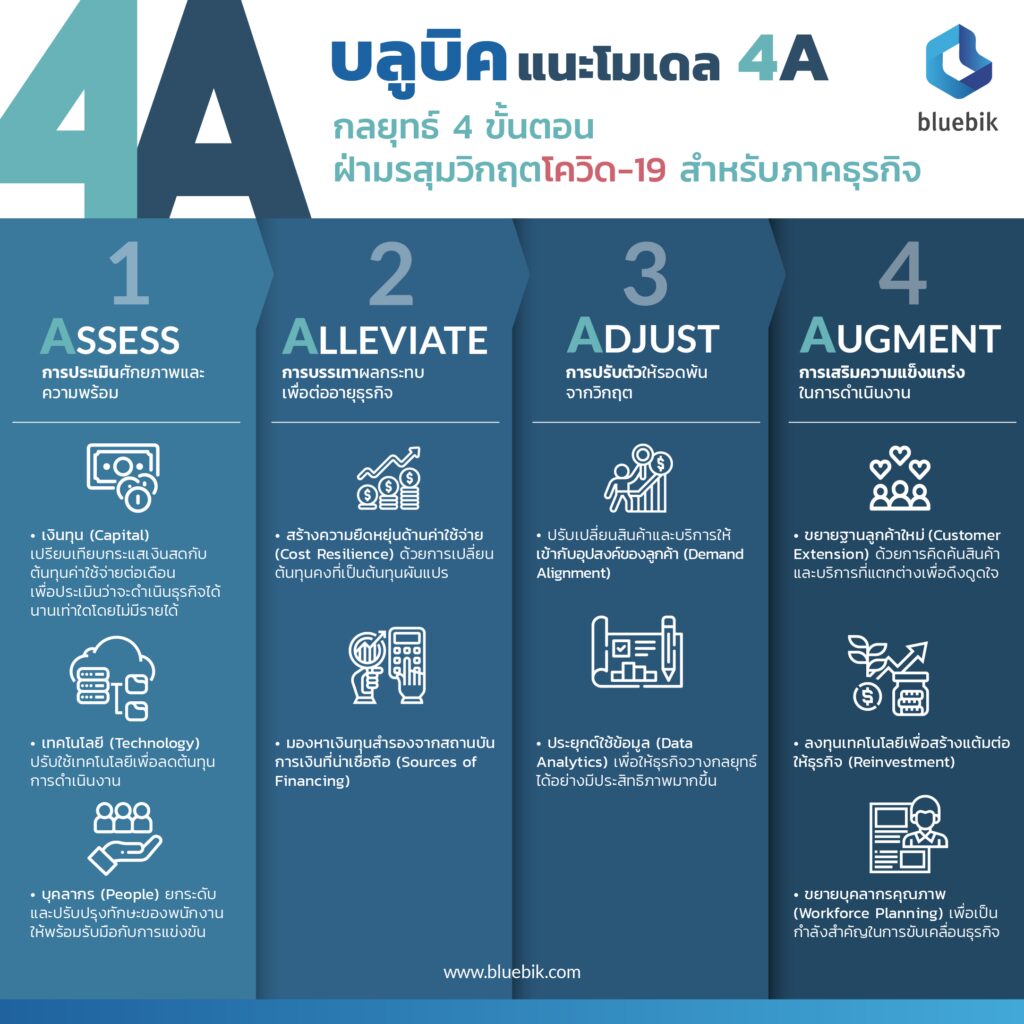เมื่อธุรกิจเผชิญวิกฤตที่ส่งผลกระทบต่อกระบวนการดำเนินงานจนสูญเสียโอกาสในการสร้างรายได้ โดยหากไม่มีการปรับตัว เพื่อให้ธุรกิจได้รับผลกระทบน้อยที่สุด อาจทำให้ขีดความสามารถในการแข่งขันหลังภาวะวิกฤตตามหลังคู่แข่ง
ดังนั้น แต่ละองค์กรจึงต้องค้นหาก้าวย่างที่เหมาะสมในการดำเนินงาน รู้จักหยุดเพื่อวางแผนปรับปรุงระบบต่าง ๆ ภายในองค์กร เมื่อธุรกิจยังมีความเสี่ยงสูงที่จะได้รับผลกระทบจากสถานการณ์ที่เกิดขึ้น และกลับมาลงทุนอีกครั้งด้วยศักยภาพที่แข็งแกร่งมากขึ้น เมื่อสถานการณ์เริ่มคลี่คลายไปในทิศทางที่ดี

4 ขั้นตอนโมเดล 4A กลยุทธ์ฝ่ามรสุมวิกฤตสำหรับภาคธุรกิจ
1. การประเมินศักยภาพและความพร้อม (Assess)
ขั้นตอนแรกในการเอาตัวรอดของธุรกิจ คือ การเร่งประเมินศักยภาพและความพร้อม 3 ด้าน เพื่อให้ทราบว่า ด้วยทรัพยากรที่มีอยู่เพียงพอที่จะพาธุรกิจให้รอดพ้นจากวิกฤตที่กำลังเผชิญหรือไม่ ดังนี้
เงินทุน (Capital)
ปัจจัยแรกที่ธุรกิจต้องประเมิน คือ เงินสดและระยะเวลาที่สามารถดำเนินกิจการโดยไม่มีรายได้ (Cash Runway) เข้ามาหมุนเวียนเพื่อเพิ่มสภาพคล่อง รวมทั้งต้องวิเคราะห์ต้นทุนค่าใช้จ่ายต่อเดือนในปัจจุบัน (Burn Rate) โดยต้องประเมินทั้งภาพที่ดีที่สุด (Best-case Scenario) และภาพที่เลวร้ายที่สุด (Worst-Case Scenario) เพื่อพิจารณาหาจุดตัดสินใจ (Cut-off) สำหรับการปรับกลยุทธ์ในการทำธุรกิจ อาทิ การปรับลดขนาดธุรกิจ (Downsizing) หรือการเร่งหาเงินทุนสำรอง เป็นต้น
เทคโนโลยี (Technology)
เร่งประเมินศักยภาพของเทคโนโลยีที่มีอยู่ เพื่อพิจารณานำเทคโนโลยีใหม่ ๆ เข้ามาเสริมทัพสร้างความยืดหยุ่นและลดต้นทุนการดำเนินงาน อาทิ การนำระบบ Cloud Computing หรือ Software-as-a-Service มาปรับใช้ เพื่อช่วยให้องค์กรสามารถลดค่าใช้จ่ายจำนวนมาก จากการลงทุนติดตั้งระบบซอฟต์แวร์และฮาร์ดแวร์แบบ On-Premise ซึ่งนอกจากจะประหยัดต้นทุน ยังช่วยลดความยุ่งยากในขั้นตอนการติดตั้งและการดูแลรักษาระบบ ที่สำคัญยังทำให้เกิดความสะดวกในการทำงานได้ทุกเวลาและสถานที่ เนื่องจากระบบจะเชื่อมต่อกับอินเทอร์เน็ต
บุคลากร (People)
องค์กรควรประเมินความสามารถ (Competency) และทักษะ (Skills) ของบุคลากรให้รองรับการเติบโตของธุรกิจในระยะยาว ด้วยการเสริมขีดความสามารถผ่านการยกระดับทักษะ (Upskill) ควบคู่กับการนำทักษะเดิมมาปรับปรุงและพัฒนา (Reskill) ให้พร้อมรับมือกับการแข่งขันหลังวิกฤต อาทิ ทักษะด้านความคิดสร้างสรรค์และนวัตกรรม ทักษะการคิดวิเคราะห์และทักษะการปรับตัว รวมถึงเปิดรับการเรียนรู้สิ่งใหม่ ๆ นอกจากบุคลากรจะมีความสามารถเพิ่มขึ้น ยังเป็นการเพิ่มระดับความผูกพันและความจงรักภักดีต่อองค์กรด้วย

2. การบรรเทาผลกระทบเพื่อต่ออายุธุรกิจ (Alleviate)
การปรับลดต้นทุนการดำเนินงาน เพื่อรักษากระแสเงินสดไว้ให้นานที่สุด เป็นหลักการสำคัญในการประคองธุรกิจท่ามกลางภาวะวิกฤต เพื่อให้สามารถนำเงินทุนเหล่านั้นไปบรรเทาผลกระทบด้านต่าง ๆ ได้อย่างคล่องตัวมากขึ้น โดยควรดำเนินการควบคู่กับการมองหาแหล่งเงินทุนใหม่ ๆ เพื่อรองรับสถานการณ์ไม่คาดคิดที่อาจเกิดขึ้น ได้แก่
การสร้างความยืดหยุ่นด้านค่าใช้จ่าย (Cost Resilience)
ด้วยการปรับลดค่าใช้จ่ายที่ไม่จำเป็น ถือเป็นสิ่งที่ธุรกิจต้องทำอย่างเร่งด่วน โดยเฉพาะการปรับเปลี่ยนต้นทุนคงที่ (Fixed Cost) ซึ่งมักเป็นต้นทุนระยะยาวและไม่ก่อให้เกิดรายได้ ให้กลายเป็นต้นทุนแปรผันตามรายได้ (Variable Cost) ที่หากไม่มีรายได้ก็จะไม่มีรายจ่ายเกิดขึ้น ซึ่งจะช่วยเพิ่มโอกาสในการอยู่รอดของธุรกิจ อาทิ การจ้างผู้เชี่ยวชาญจากภายนอก (Outsource) เข้ามาดูแลโปรเจกต์เพื่อลดการจ้างพนักงานประจำ การหาพันธมิตรทางธุรกิจ (Business Partner) เพื่อลดต้นทุนการดำเนินงานบางขั้นตอน หรือแม้กระทั่งการนำเทคโนโลยีบางประเภท เช่น Cloud Computing หรือ Software as a Service (SaaS) เข้ามาใช้เพื่อลดต้นทุนด้านเทคโนโลยี
การมองหาเงินทุนสำรอง (Sources of Financing)
ธุรกิจควรเริ่มมองหาแหล่งเงินทุนสำรองหรือเข้าร่วมโครงการ เพื่อบรรเทาผลกระทบจากสถาบันการเงิน อาทิ สินเชื่อดอกเบี้ยต่ำ (Soft Loan) สินเชื่อรายเล็ก (Small Business Loan) พร้อมทั้งประเมินสถานการณ์เลวร้ายที่สุดที่อาจเกิดขึ้น (Worst-Case Scenario) เพื่อหากลยุทธ์ที่เหมาะสมมารองรับการดำเนินธุรกิจ
3. การปรับตัวให้รอดพ้นจากวิกฤต (Adjust)
สภาวะวิกฤตเป็นปัจจัยที่ทำให้พฤติกรรมผู้บริโภคเปลี่ยนแปลงไป รวมถึงความสามารถในการจับจ่ายใช้สอยที่ลดลง ส่งผลให้ธุรกิจต้องปรับตัวเพื่อให้สินค้าและบริการ ยังเป็นหนึ่งในตัวเลือกของลูกค้า ดังนั้น เพื่อที่จะทราบว่าลูกค้ากลุ่มใดมีศักยภาพและควรเป็นกลุ่มเป้าหมายหลัก จำเป็นต้องนำศาสตร์ด้านข้อมูลเข้ามาช่วยในกระบวนการคัดกรอง ซึ่งจะทำให้การขับเคลื่อนแผนธุรกิจและการสื่อสารการตลาดมีโอกาสประสบความสำเร็จมากขึ้น
ความสามารถในการปรับเปลี่ยนผลิตภัณฑ์และบริการให้เข้ากับอุปสงค์ของลูกค้า (Demand Alignment)
ภาวะวิกฤตทำให้พฤติกรรมการใช้จ่ายของลูกค้าเปลี่ยนไป กำลังซื้อลดลง เกิดการมองหาสินค้าและบริการที่มีความคุ้มค่าสูงมาทดแทน ดังนั้น ธุรกิจต้องปรับตัวเพื่อไม่ให้สูญเสียโอกาสในการสร้างรายได้ อาทิ การปรับลดราคาสินค้า เพื่อดึงดูดให้ลูกค้าเกิดความสนใจและตัดสินใจซื้อทันที หรือการจัดแคมเปญการตลาด เพื่อประชาสัมพันธ์ให้ลูกค้ารับทราบถึงสินค้า หรือบริการรูปแบบใหม่ที่ตอบโจทย์ความต้องการมากขึ้น
การประยุกต์ใช้ข้อมูล (Data Analytics)
การนำฐานข้อมูลขนาดใหญ่ (Big Data) เข้ามาปรับใช้จะทำให้ธุรกิจสามารถตัดสินใจ เพื่อวางกลยุทธ์ได้อย่างมีประสิทธิภาพมากขึ้น อาทิ การวิเคราะห์กลุ่มเป้าหมายเพื่อพิจารณางบประมาณในการทำการตลาดให้ตรงจุด และนำข้อมูลมาวิเคราะห์ เพื่อให้ทราบว่าใครคือกลุ่มลูกค้าเป้าหมายที่มีกำลังซื้อ เพื่อที่จะสามารถคาดการณ์ยอดขายได้อย่างแม่นยำ รวมทั้งสามารถสร้างสรรค์ผลิตภัณฑ์และนำเสนอให้ตอบโจทย์ความต้องการของลูกค้าอย่างแท้จริง

4. การเสริมความแข็งแกร่งในการดำเนินงาน (Augment)
เมื่อวิกฤตคลี่คลายและกำลังซื้อเริ่มกลับเข้าสู่ภาวะปกติ ธุรกิจที่มีเงินทุนและศักยภาพการดำเนินงานมากเพียงพอควรลงทุนเทคโนโลยี โครงสร้างพื้นฐานที่จำเป็น และทรัพยากรคนคุณภาพสูง เพื่อเร่งสร้างความได้เปรียบในการแข่งขันก่อนธุรกิจอื่น พร้อมทั้งเสริมความแข็งแกร่งด้วยการมองหาแหล่งรายได้ใหม่จากทั้งลูกค้ากลุ่มใหม่ และกลุ่มที่มีอุปสงค์ในสินค้าหรือบริการนั้นแล้วแต่เป็นลูกค้าของแบรนด์คู่แข่ง ผ่านการนำเสนอ “จุดขาย” ที่จะทำให้คนทั้งสองกลุ่มกลายมาเป็นลูกค้าของเรา
ส่วนธุรกิจที่ยังไม่มีความพร้อมสำหรับการลงทุนทุกด้านในช่วงเวลาเดียวกัน อาจเริ่มจากการลงทุนในส่วนที่จะเสริมศักยภาพการดำเนินงานให้กับธุรกิจได้มากที่สุดเป็นลำดับแรก จากนั้นจึงทยอยลงทุนให้ครบถ้วนเพื่อเสริมความแข็งแกร่งให้ธุรกิจ
การขยายฐานลูกค้าใหม่ (Customer Extension)
นอกจากการรักษาฐานลูกค้าเดิมที่มีแนวโน้มจะสร้างรายได้ให้บริษัทฯ อย่างสม่ำเสมอ ธุรกิจยังจำเป็นต้องแสวงหาลูกค้าใหม่ด้วยการนำเสนอสินค้า บริการ และสิทธิประโยชน์ที่มีความแตกต่างผ่านช่องทางการสื่อสารการตลาดที่มีประสิทธิภาพ และสามารถเข้าถึงกลุ่มลูกค้าเป้าหมายได้โดยตรง อาทิ การทำการตลาดแบบส่วนบุคคล (Personalized Marketing) และการทำการตลาดผ่านช่องทางอีเมล (Email Marketing) โดยมีเป้าหมายเพื่อเพิ่มส่วนแบ่งทางการตลาดให้กับองค์กร ทั้งจากการดึงดูดกลุ่มลูกค้าที่ยังไม่เคยซื้อสินค้าและบริการดังกล่าวมาก่อน (New User) และการดึงลูกค้าจากแบรนด์คู่แข่งให้หันมาซื้อสินค้า และบริการของเราแทน
การลงทุนเพื่อสร้างแต้มต่อให้ธุรกิจ (Reinvestment)
ธุรกิจที่ยังมีศักยภาพการดำเนินงานในระดับสูง ควรเร่งลงทุนเทคโนโลยีและโครงสร้างพื้นฐานที่จำเป็น เพื่อเสริมความได้เปรียบ สร้างมูลค่าเพิ่ม และเพิ่มขีดความสามารถในการแข่งขันหลังวิกฤต ส่วนธุรกิจที่มีศักยภาพค่อนข้างจำกัด อาจเริ่มลงทุนในส่วนที่จะสามารถยกระดับประสิทธิภาพการดำเนินงานได้มากที่สุดเป็นอันดับแรก โดยข้อดีของการลงทุนในช่วงนี้ คือ มีอัตราต้นทุนค่าเสียโอกาส (Opportunity Cost) อยู่ในระดับที่ต่ำกว่าการลงทุนในภาวะปกติ
วางแผนปรับโครงสร้างและขนาดองค์กร ด้วยการขยายบุคลากรคุณภาพ (Workforce Planning)
เพื่อให้มีความพร้อมให้การทำงานเป็นไปอย่างคล่องตัว และมีประสิทธิภาพสูงสุดได้ทันทีหลังสถานการณ์คลี่คลาย องค์กรจึงควรมีแผนในการสรรหาบุคลากรคุณภาพสูงเข้ามาร่วมงานที่เหมาะสม เพื่อเป็นกำลังสำคัญในการขับเคลื่อน และสร้างการเติบโตอย่างยั่งยืนให้กับธุรกิจ พร้อมทั้งแผนในการเพิ่มขีดความสามารถให้กับพนักงานในด้านต่าง ๆ
กุญแจสำคัญของการเอาชนะวิกฤต คือ ความพร้อมในการปรับตัวให้ทันต่อความเปลี่ยนแปลง เพื่อให้ธุรกิจสามารถฟันฝ่าความท้าทาย และได้รับผลกระทบน้อยที่สุด พร้อมทั้งควรต่อยอดหรือแสวงหาโอกาสใหม่ ๆ จาก New S-Curve เพื่อเป็นกลไกในการขับเคลื่อนองค์กรในอนาคต เพราะในทุกวิกฤตย่อมมีโอกาสแฝงอยู่เสมอ ดังนั้นหากธุรกิจสามารถเรียนรู้และหาหนทางในการแก้ไขปัญหา จะสามารถมองเห็นโอกาสที่เป็นทางเลือกสู่ทางรอดท่ามกลางวิกฤตแน่นอน
สำหรับธุรกิจที่ต้องการวางกลยุทธ์เพื่อเพิ่มศักยภาพการแข่งขัน และสร้างการเติบโตให้องค์กร บลูบิค (Bluebik) ในฐานะที่ปรึกษาชั้นนำผู้ให้บริการดิจิทัลทรานส์ฟอร์เมชันครบวงจร มีทีมงานผู้เชี่ยวชาญพร้อมให้บริการที่ปรึกษาการบริหารจัดการโครงการเชิงกลยุทธ์ หรือ Strategic PMO ที่สามารถให้บริการโซลูชันครบวงจร และการวิเคราะห์ข้อมูลขั้นสูง ตั้งแต่ระดับกลยุทธ์ไปจนถึงการนำไปปรับใช้ให้เหมาะสมกับองค์กร ผู้สนใจสามารถติดต่อสอบถามหรือปรึกษาได้ที่ [email protected] หรือโทรศัพท์ 02-636-7011 เรียนรู้และหาหนทางในการแก้ไขปัญหา จะสามารถมองเห็นโอกาสที่เป็นทางเลือกสู่ทางรอดท่ามกลางวิกฤตแน่นอน













